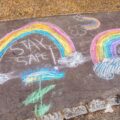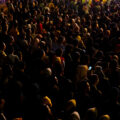Home alone: digital religion
Home alone: Digital religion
In these strange times, the use of digital technology has risen rapidly. Not only for business and culture, but also for religion. A key part of religion is gathering and experiencing faith together. However, these feelings of connection are being challenged as many religious communities are taking their activities online. Can believers still feel connected to each other, their practices, and their faith, if they are home alone?
God goes digital
After COVID-19 was declared a pandemic in March 2020, countries across the world went into lockdown. Europe – the pandemic epicentre at the time – saw its countries take a range of steps to stop the spread of COVID-19, including social distancing. Large gatherings were canceled and prohibited until further notice. These include not only conferences, sporting events, and festivals, but also religious congregations. All major religions in Europe – Christianity, Islam, and Judaism – have been hit hard by these restrictions. While the suspension of religious gatherings was slow in some countries, and often attributed to the initial spread of the virus, almost all churches, synagogues, and mosques are now closed to the larger public. Under these lockdown conditions, the question for religious communities has been how to stay in touch with their fellow believers, and importantly, how to practice religious celebrations such as Passover, Ramadan, and Easter. A compelling answer to these communities has been embracing digital possibilities. Religious communities have eagerly accepted many of these. But this has not proven to be straightforward, with some communities indeed struggling to relocate their religion from their traditional places of worship to the Internet. So, has God gone, or can God even go, truly digital?
Streaming services and priest ‘on wheels’
Religion is not new to digital technology. Well before the COVID-19 pandemic, evangelical Christian communities were using social media to reach their audience;[1] Muslims were using faith apps to manage prayers with personalised call to prayers; and rabbis were routinely officiating live-streamed funeral services.[2] But now that the COVID-19 pandemic is set to continue for months if not years, most believers have been pushed to go beyond these small digital embraces to figure out how to meaningfully take their entire religions fully digital.
Communities have been now called to reinvent their churches, synagogues, and mosques, and the responses have been predictably uneven. While most evangelical and young churches have been able to adapt themselves to already familiar digital territory, by streaming their celebrations for example, more orthodox communities still have had to find out how they could reach their community in a different way. Some responses, however, have been surprising. In the Catholic Church, Pope Francis led the way: after celebrating Mass in St Peter’s Church on his own for several weeks, he began streaming these services online.[3]
For many clergymen, celebrating alone in the church is a strange feeling. Some try to defeat this ‘loneliness’ by gluing photos of members of their congregation to church benches, so that it looks like they are still together, such as Pastor Hermann-Josef Ludwig in Boppard, Germany.[4] Others have taken things a step further than just broadcasting normal masses and services online. In Wrexham, Wales, Heather Shotton has been licensed as a curate via Zoom.[5] And besides the fact that many churches take their services online, there are also initiatives to take the church to the people. Reverend Pat Allerton from Notting Hill, UK, has set up a ‘mobile church service’.[6] With his car, he drives around neighbourhoods, and a prayer and hymn can be heard via his speaker. This way, people can still celebrate the church service together. In Italy, Pope Francis has been leaving the Vatican to pray at different churches in Rome.[7]
Jewish communities followed a similar path, focusing on the challenge of taking synagogue celebrations online for Passover. Passover is a weeklong feast, during which the liberating exodus out of Egypt by the Israelites is remembered and celebrated. It is a feast during which families comes together. But with the lockdown restrictions, everyone has been urged to stay at home and to celebrate Passover by themselves. In order to still be together, people have used digital communications during the Seder meal, even though technology is traditionally not allowed during Seder. In many ways, how far a community goes digital depends on how orthodox it is. Many communities have found a way out of these constraints as well: most communities allow digital communications during Seder as long as the digital technology is turned on before the Seder starts.[8] [9]
Religion is about being together
Besides the practical possibilities of taking religious celebrations online, there are other voices that claim that God cannot go digital.[10] The President of the Central Committee of German Catholics Thomas Stenberg, for example, argues how the Eucharist – the leading physical celebration – has all but disappeared now and cannot be recovered.[11] Besides, singing and praying together is mostly experienced better. Some religious leaders are disregarding the crisis itself to continue holding their services physically as before, with many people present. They in fact argue that such services become even more essential. Funeral masses in Ireland, for example, have become a key practice despite COVID-19 restrictions and despite the fact that Catholicism has been declining in the country. While Ireland’s Archbishop Diarmuid Martin encouraged parishioners to embrace digital technology to live stream funeral masses, many rural dioceses refused to go online: funeral masses in fact gained new meaning in rural Ireland, becoming events of community resilience in the face of the pandemic challenges. In the Netherlands, some church gatherings with up to 30 people present still continue under the country’s freedom-of-faith law, which protects rather than stops such activities.[12]
God goes digital?
At a time when physical distances are difficult to overcome in Europe, digital technology has made it possible for social connectedness to persevere. Jews host virtual Seder meals. Christians virtually observe Good Friday. Muslims run virtual Iftars. But for some, going digital breaks both the rule and spirit of the very religious experience they seek to practice. For instance, orthodox Jews in France still refuse to celebrate Sabbath without being able to meet physically.[13] So while for many across Europe, the search for God has gone digital, for some, this search is only possible in ‘actual’ places, close to others.
Astrid Hamberg and Muhammad Faisal Khalil
Want to know more about similar topics? Go to the EARS Dashboard and receive free weekly updates.
Go to all news items ->
[1] De kerk is leeg, de gelovige zit thuis: wat nu?
[2] App faith: how religions are embracing technology | Religion
[3] Coronavirus, grazie ai media è possibile vivere la Quaresima da casa
[4] Trotz Corona volle Bänke in Bopparder Kirche
[5] Coronavirus: Zoom church service sees Wrexham priest licensed
[6] Coronavirus: ‘portable priest’ offers mobile church service to lift spirits of londoners
[7] Papa a piedi in centro a Roma va a venerare il crocifisso miracoloso che fermò la peste nel 1522
[8] Chief Rabbi: Zoom seders not allowed but tech can ‘enhance Pesach experience
[9] Israel prepares for a Seder night different from all other Seder nights
[10] Koronaviruspandemia merkki lopun ajoista? Osalle uskonnollisista liikkeistä Ilmestyskirjan ennustukset ovat käymässä toteen, osa ei näe koronaa viimeisenä merkkinä
[11] Kirche und Glaube in Coronazeiten – Der Gottesdienst “fehlt schon sehr”
[12] Ook in de bijbelgordel is de kerk vrijwel leeg: ‘Natuurlijk doet dit pijn’
[13] Chief Rabbi: Zoom seders not allowed but tech can ‘enhance Pesach experience’






